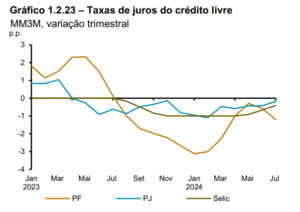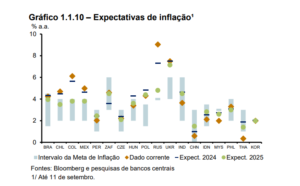The impact of Brazilian monetary policies on the commodities market
Understand how Brazilian monetary policies influence commodity market prices, with Victor Arduin – Energy and Macroeconomics Analyst at Hedgepoint
Brazil’s monetary policies are strategies adopted by the Central Bank of Brazil (BC) to control the money supply and pursue the country’s inflation target. According to the Central Bank itself, price stability preserves the value of money by maintaining the purchasing power of the currency.
As Brazil is one of the largest global producers and exporters of commodities, monetary decisions have a direct impact on the competitiveness of Brazilian products on the international market. That’s why we invited Hedgepoint’s Energy and Macroeconomics analyst, Victor Arduin, to discuss this influence and its role in the Brazilian economy. Read on and enjoy!
The impact of monetary policies on Brazilian commodities
 Monetary policies, as Arduin explains, have the main objective of controlling inflation or, in some special cases, deflation. “The latter indicates a lack of consumption in the economy, which can lead to a recessionary scenario, with a loss of jobs and income,” adds Victor
Monetary policies, as Arduin explains, have the main objective of controlling inflation or, in some special cases, deflation. “The latter indicates a lack of consumption in the economy, which can lead to a recessionary scenario, with a loss of jobs and income,” adds Victor
In Brazil, monetary policies are traditionally focused on reducing inflation. According to Hedgepoint’s Energy and Macroeconomics analyst, this is a common characteristic among emerging countries.
This is why the profile of monetary actions in Brazil is usually more restrictive. In this case, the Central Bank raises interest rates, making credit more expensive and reducing consumption and investment. This helps to reduce the amount of money in circulation and control inflation.
Read also:
- Understand monetary policies and the weight of Asian rates on the foreign exchange market
“Furthermore, when Brazil raises interest rates, it creates an attractive differential in relation to foreign economies, encouraging an influx of dollars into the country. This influx of capital helps to appreciate the exchange rate, but can harm the competitiveness of our commodities,” adds Arduin.
The professional also explains that the effect is reversed in the case of more expansive monetary policies, used to stimulate the economy in times of recession or slow growth. In this scenario, the Central Bank reduces interest rates to facilitate credit and stimulate consumption. With more money circulating, demand for products and services tends to grow, stimulating the economy.
“This measure could lead to a depreciation of the Real and an increase in inflation. However, this tends to make Brazilian commodities more competitive on the global market, encouraging product exports,” concludes the expert.
Read also:
- Coffee in South America: expectations for the Brazilian and Colombian harvests
The current scenario of Brazilian monetary policies
Currently, Brazil’s monetary policies remain more restrictive. The basic interest rate, Selic, was recently increased and remains high compared to other economies.
“This affects the cost of borrowing for the commodities and agribusiness sector, even though there are subsidized credit lines for certain segments. These incentives allow producers to expand their investments at lower interest rates, but they can create distortions in the cost for other sectors,” says Arduin.
● The Brazilian Selic rate
Currently, the Selic rate is 11.25% per year, a figure set by the Central Bank’s Monetary Policy Committee (Copom). In September 2024, the institution also published a retrospective of the Selic rate since January 2023. See below:

Source: Central Bank of Brazil
● Inflation data
With regard to inflation, the Central Bank’s data reiterates the position of the Hedgepoint expert. Compared to other economies, Latin American countries have higher inflation rates and tighter monetary policies. Brazil maintains inflation within the target range, but at the upper limit. Expectations for 2025 remain at the same levels. See:

Source: Central Bank of Brazil
● Public debt
Victor Arduin also points out that Brazil’s growing public debt poses risks for the national economy. According to the expert, high debt levels put pressure on the currency and can reduce investor confidence.
“The country’s economic situation deserves a ‘yellow light’, especially given the impact that the increase in debt could have on investors,” adds the analyst.
Read also:
- The bioenergy market in Brazil
The volatility of the Brazilian currency
Brazil’s history with currency instability is not recent. In the 1980s and 1990s, the Latin American country faced inflation rates that reached 2,500% a year. This economic downturn began in 1979 with the second international oil crisis. In 1994, the country managed to implement the Real Plan, equalizing the purchasing power of the Brazilian currency with the US dollar at the time.
“The Real Plan was a response to the inertial inflation Brazil was experiencing. To contain the loss of purchasing power, it was necessary to create a new currency that would generate confidence and stabilize inflation, combined with fiscal adjustments to balance public accounts,” adds Victor.
Currently, Brazilian inflation is more contained, but it is still more volatile when compared to more competitive currencies, such as the Euro and the Dollar. In 2023, Brazil’s inflation reached 4.6%, a relatively high figure, but still within the National Monetary Council’s target
The Hedgepoint expert points out that “maintaining a balance in monetary policies is essential. An excessively depreciated currency can generate inflation, and this affects the cost of living in the country, even if it brings gains in competitiveness for exporters.”
Read also:
- Understand what currency hedging is and how it works
Hedging and Brazilian monetary policies
Victor Arduin points out that hedging can help mitigate the impacts of Brazil’s monetary policies, especially in contexts of high exchange rate and commodity price volatility. According to the expert, “hedging tools become a financial layer of protection for producers and exporters”.
A monetary policy that strengthens the Real, for example, could have a negative impact on the revenue of companies that work with commodities. Hedging allows these companies to lock in a minimum price for their future sales, guaranteeing a pre-agreed financial return, even if the Real’s purchasing power changes.
Contact Hedgepoint and learn more about FX hedging from one of our experts.






